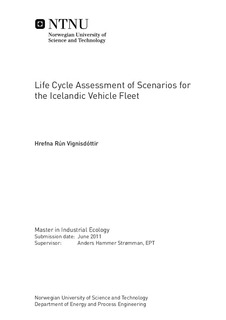Life Cycle Assessment of Scenarios for the Icelandic Vehicle Fleet
Master thesis
Permanent lenke
http://hdl.handle.net/11250/234476Utgivelsesdato
2011Metadata
Vis full innførselSamlinger
Sammendrag
Environmental issues, foremost global warming and climate change, are attracting more and more attention in world discussion as the global community constantly works on an agreement for actions to limit it. Global warming and climate change are human induced greenhouse effects that are a direct result of burning fossil fuels. Global warming is not the only problem of using fossil fuels. It is estimated that recoverable fossil energy reserves can only meet the demand for energy until 2050, if demand stabilizes at a current level. Iceland has commitments to reduce emissions contributing to global warming and as the transportation sector makes up a considerable proportion of the total emissions therefore the analysis of that sector is important. The overall aim of this report is therefore to analyze the life cycle emissions of the Icelandic vehicle fleet from 1990 to 2010 and then to develop possible and necessary scenarios for the future development of the fleet. Emissions of the Icelandic vehicle fleet are calculated using a life cycle approach. First the historical model used to calculate past emissions is defined along with the relevant parameters. Additional parameters for the scenario model, for three different scenarios: the reference; the green and the target, are presented and further calculations explained. The results show that emissions in the reference scenario increases continually and by 2050 it is over three and a half times higher than the emission reduction target, while the green scenario, which assumes moderate measures, is over 2.6 times higher. The target scenario, being the only scenario getting close to the target, has a reduction in emissions at 67% by 2050 compared to 2010. The model gives a clear indication of the development of the service provided, and shows that there is little reduction in the population s overall mobility in the reference and green scenarios, while the kilometers driven per person returns to 1990 level in the target scenario. The model indicates that reaching the emission reduction goal that the Icelandic government has announced seems very unlikely if all sectors are to reduce emissions equally. It is clear that action needs to be taken immediately in Iceland and elsewhere if international goals are to be kept.
